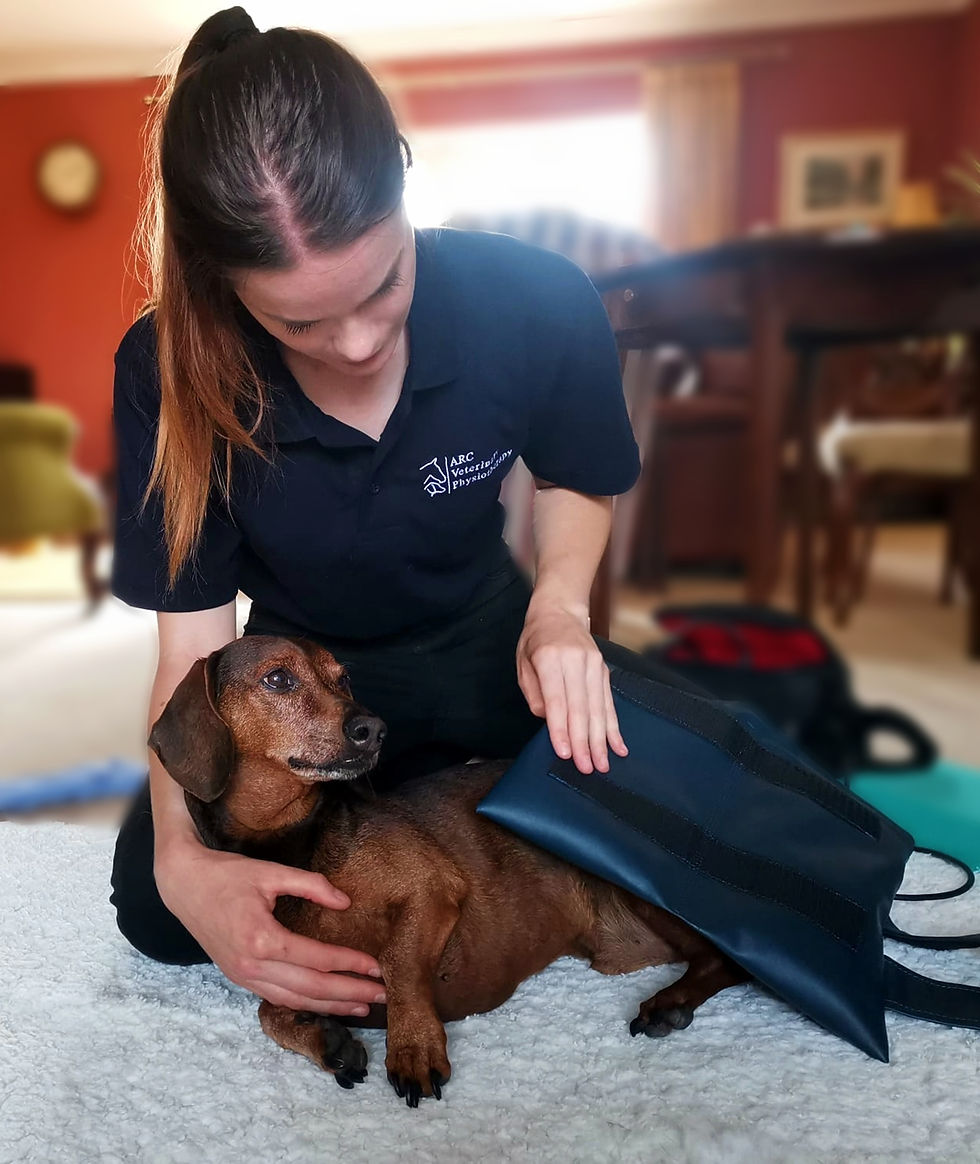Canine Conditions: Hip Dysplasia
- arcvetphys
- Jul 19, 2023
- 4 min read
Updated: Jul 26, 2023

What is Hip Dysplasia?
Canine hip dysplasia is a common condition in dogs, occurring in 15.6% of the population. Hip dysplasia is caused by the abnormal development of the hip joint, resulting in pain and restricted hip and hindlimb use. The hip joint is a ball and socket joint and when abnormal development of the joint occurs, the head of the femur does not sit correctly in the pelvis (acetabulum), meaning that the joint cannot glide smoothly or function appropriately causing uneven wear, ultimately leading to loss of function and osteoarthritis later on in life.

What causes hip dysplasia?
There are several factors that can contribute to the development of canine hip dysplasia. Genetics are primarily responsible, with Labradors, German Shepards, Great Danes, Rottweilers, Saint Bernards, and American Staffordshire Terriers being most at risk of developing the condition. There are currently estimated to be over 100 gene codes for hip dysplasia. However, environmental factors may also play a role such as obesity and rapid growth during puppyhood. However, it should be recognised that environmental factors cannot cause hip dysplasia, but they may influence whether an animal with the genetics that codes for hip dysplasia develops a clinical issue.
What are the symptoms?
Some dogs may start to show clinical symptoms as young as four months old. Others may only start to develop symptoms later in life when osteoarthritis begins to develop. Symptoms will also vary depending on the severity of the dysplasia, the level of inflammation and incongruity within the joint, and how long the dog has been suffering from the condition. Symptoms to look out for can include:

Difficulty standing up
Exercise intolerance
Reluctance to climb stairs, jump, run
Narrow stance
Stiffness
Abnormal gait (sometimes seen as swaying behind when walking or bunny hopping)
Guarded of the hip area
Increased aggression towards, humans, children and other dogs
"Grumpiness" after exercise
Lameness
Unable to sit square
Biting at the hind end
How can it be diagnosed?
If your primary care veterinarian suspects possible hip dysplasia, radiographs can be performed of your dog's hip joints. Radiographs will usually show changes occurring within the hip joint of affected dogs. However, this is not always the case and more complex cases may require CT scans. An "Ortolani test" under general anaesthetic may also be performed to assess the degree of laxity within the hip. In most cases, your dog will be referred to a specialist orthopaedic surgeon for a consultation. A provisional diagnosis and course of action can then be discussed with you.
What are the treatment options?
The treatment your dog receives for hip dysplasia is dependent on many factors, specifically the severity. A brief overview of the different treatment options are listed below.
Conservative treatment:
Conservative management may be recommended in mild cases showing minimal clinical symptoms. This mostly comprises of nutritional management, weight control, physiotherapy, and pain management. Conservative treatment cannot change the degeneration that has already occurred, but it can help to reduce compensations and pain and strengthen the surrounding structures to increase hip stability.
Triple Pelvic Osteotomy (TPO):
This is a surgery that involves the cutting and re-settng of the pelvis to change the inclination angles. This results in a better fit of the hip joint and changes the distribution of forces. However, due to growth plates, this can only be performed between 4-5.5 months of age.
Total Hip Replacement:
This surgery involves the complete replacement of the ball and socket joint, replacing them with implants. This prevents the development of osteoarthritis and restores normal hip function. The implants can be attached using a cement or cement-less system. The success rate of this surgery is about 90-95% with most dogs returning to full activity levels.
Femoral Head and Neck Excision (FHNE):
This is often used as a salvage procedure that is considered in cases where a total hip replacement cannot be performed (financial reasons, Legg Perthes disease). This surgical technique involves the removal of the top part of the femur (the ball part of the joint). The body will then form a false joint stabilised by the soft tissues. This relieves pain within the hip joint however, it typically limits function and surgical results can be unpredictable. The prognosis of this surgery is better in small breeds.
Juvenile Pubic Symphysiodesis (JPS):
This surgical technique involves induced fusion of a part of the pelvis (the pubis on the underside) that can cause alteration to growth that allows for better congruity within the hip joint. However, this surgery can only be performed in dogs under 5 months of age with mild-moderate laxity. As clinical signs are often not visible until 6 months this surgery is often only used to prevent the development of hip dysplasia.
Physiotherapy for Hip Dysplasia

Physiotherapy can aid hip dysplasia following surgery or during conservative management
utilising a range of treatment modalities suited to the dog's individual case and stage of healing/pathology. A unique rehabilitation plan will be designed for your dog including at-home exercises. Hydrotherapy can also be beneficial for dogs suffering from hip dysplasia.
For more details contact ARC Veterinary Physiotherapy:
Email: info@arcvetphysio.co.uk
Tel: 07527310689
References:
Inbreeding by Breed. Open Journal of Veterinary Medicine. 2014.
Dycus, D.L., Levine, D., Marcellin-Little, D.J. (2017) Physical Rehabilitation for the Management of Canine Hip Dysplasia. Veterinary Clinics of North America: Small Animal Practice. 47(4), 823–850.
Fitzpatrick Referrals (2023) Hip dysplasia. Fitzpatrick Referrals. [online]. Available from: https://www.fitzpatrickreferrals.co.uk/orthopaedic/hip-dysplasia/ [Accessed July 14, 2023].
Ginja, M.M.D., Silvestre, A.M., Gonzalo-Orden, J.M., Ferreira, A.J.A. (2010) Diagnosis, genetic control and preventive management of canine hip dysplasia: A review. The Veterinary Journal. 184(3), 269–276.
King, M.D. (2017) Etiopathogenesis of Canine Hip Dysplasia, Prevalence, and Genetics. Veterinary Clinics: Small Animal Practice. 47(4), 753–767.
Leighton, E.A. (1997) Genetics of canine hip dysplasia. Journal of the American Veterinary Medical Association. 210(10), 1474–1479.

ความคิดเห็น